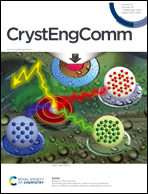Fabrication of a high-adsorption N–TiO2/Bi2MoO6 composite photocatalyst with a hierarchical heterostructure for boosted weak-visible-light photocatalytic degradation of tetracycline
Abstract
A novel Bi2MoO6/N–TiO2 hierarchical heterostructure photocatalyst was successfully fabricated through the in situ growth of Bi2MoO6 nanosheets on rough N–TiO2 nanorods with a bark-like surface, and the structure–property relationship of this composite material was researched. The results show that the unique bark-like morphology of N–TiO2 leads to superior adsorption ability, and also provides effective growth sites for Bi2MoO6 nanosheets. The growth of Bi2MoO6 nanosheets leads to the formation of a hierarchical structure, therefore increasing the adsorption ability. The heterostructure between Bi2MoO6 and N–TiO2 promotes the highly efficient separation and transfer of photogenerated carriers. These features make the Bi2MoO6/N–TiO2 composite photocatalyst exhibit outstanding photocatalytic activity, and the optimal photocatalytic degradation rate for tetracycline hydrochloride (20 mg L−1) is up to 93.76% in 90 min under weak-visible-light irradiation (5 W, LED, λ > 400 nm). After five cycling runs, the composite photocatalyst still maintains high photocatalytic activity. Holes and superoxide radicals are confirmed to be the main reactive species in the photocatalytic reaction over the Bi2MoO6/N–TiO2 composite photocatalyst.



 Please wait while we load your content...
Please wait while we load your content...